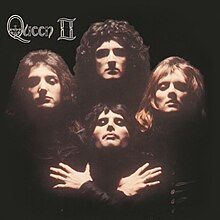
Back Queen II Afrikaans Queen II ALS Queen II AST Queen II Bulgarian Queen II BS Queen II Catalan Queen II Czech Queen II Danish Queen II German Queen II Greek
| Queen II | ||||
|---|---|---|---|---|
 | ||||
| Studio album by | ||||
| Released | 8 March 1974 | |||
| Recorded | 5 August 1973 – 20 February 1974[1] | |||
| Studio | Trident, London | |||
| Genre | ||||
| Length | 40:42 | |||
| Label | ||||
| Producer |
| |||
| Queen chronology | ||||
| ||||
| Singles from Queen II | ||||
| ||||
Queen II is the second studio album by the British rock band Queen. It was released on 8 March 1974 by EMI Records in the UK and Elektra Records in the US. It was recorded at Trident Studios and Langham 1 Studios, London, in August 1973 with co-producers Roy Thomas Baker and Robin Geoffrey Cable, and engineered by Mike Stone. It is significant for being the first album to contain elements of the band's signature sound of multi-layered overdubs, vocal harmonies, and varied musical styles.[3][4]
Described as "arguably the heaviest Queen album", Queen II marked the end of the first phase of the band's career.[5] The album combines a heavy rock sound with art rock and progressive rock elements,[3][6][7] and has been called "a pillar of grandiose, assaultive hard rock" by the Rock and Roll Hall of Fame.[8] Queen II is not a concept album but a collection of songs with a loose theme running throughout.[9] The two sides of the original LP were labelled "Side White" and "Side Black" (instead of the conventional sides A and B), with corresponding photos of the band dressed in black on the front cover and white on the inner gatefold. The white side has songs with a more emotional theme and the black side is almost entirely about fantasy, often with quite dark themes. Mick Rock's cover photograph was frequently re-used by the band throughout its career, including the music videos for the songs "Bohemian Rhapsody" (1975) and "One Vision" (1985).
Released to an initially mixed critical reception, Queen II remains one of the band's lesser-known albums. Nonetheless, it has retained a cult following since its release, and garnered praise from critics, fans,[3][10] and fellow musicians alike.
- ^ "QUEENLIVE.ca". Retrieved 12 January 2020.
- ^ "Queen singles".
- ^ a b c Cite error: The named reference
Allmusicwas invoked but never defined (see the help page). - ^ "Queen: First Five Albums Reissued - 14th March". Queen Online. 26 January 2011. Retrieved 13 April 2022.
- ^ Dome, Malcolm (29 August 2016). "Queen albums ranked from worst to best". Louder. Retrieved 6 January 2019.
- ^ Ewing, Jerry (2018). Wonderous Stories. Flood Gallery Publishing. p. 122. ISBN 978-0992836665.
- ^ Moore, Brian (8 July 2014). "Queen's Best Deep Cuts, Album by Album". Houston Press. Retrieved 7 February 2019.
- ^ Cite error: The named reference
Rock and Roll Hall of Famewas invoked but never defined (see the help page). - ^ Purvis, Georg (2011). Queen: Complete Works. Titan Books Ltd. ISBN 978-0857685513.
- ^ Cite error: The named reference
pitchforkwas invoked but never defined (see the help page).